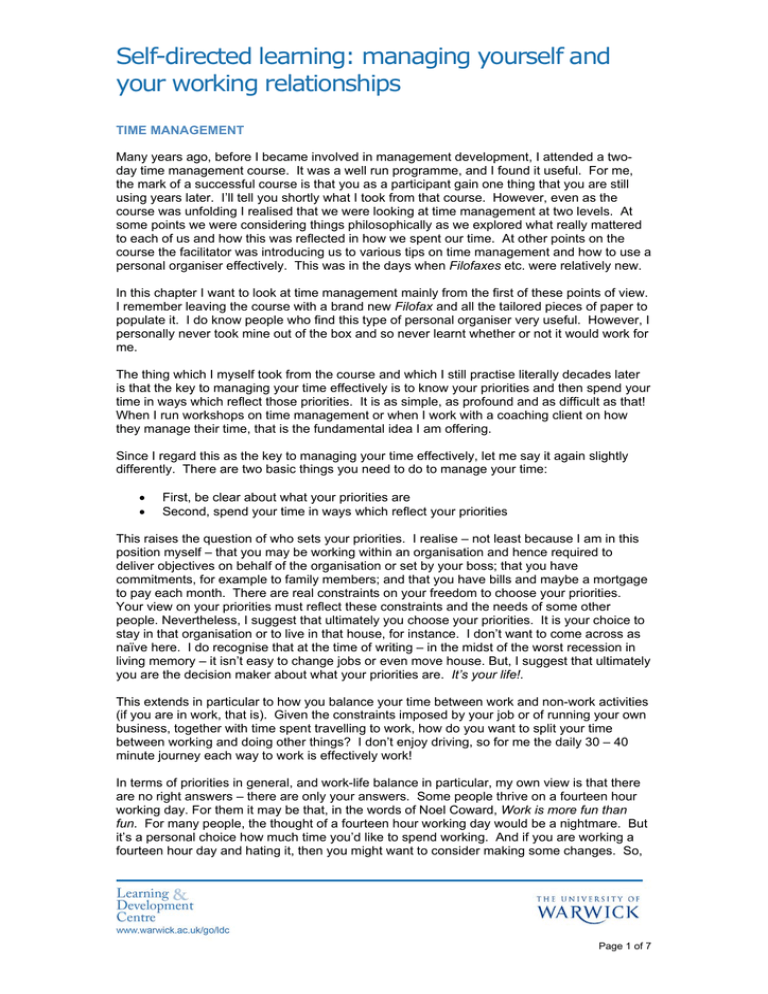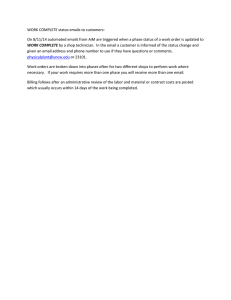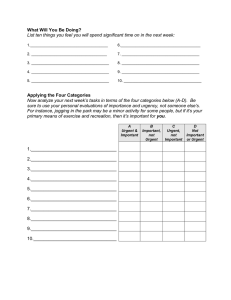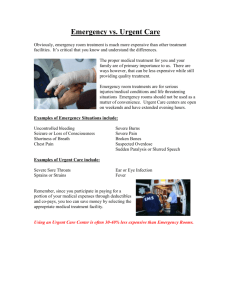Self-directed learning: managing yourself and your working relationships
advertisement

Self-directed learning: managing yourself and your working relationships TIME MANAGEMENT Many years ago, before I became involved in management development, I attended a twoday time management course. It was a well run programme, and I found it useful. For me, the mark of a successful course is that you as a participant gain one thing that you are still using years later. I’ll tell you shortly what I took from that course. However, even as the course was unfolding I realised that we were looking at time management at two levels. At some points we were considering things philosophically as we explored what really mattered to each of us and how this was reflected in how we spent our time. At other points on the course the facilitator was introducing us to various tips on time management and how to use a personal organiser effectively. This was in the days when Filofaxes etc. were relatively new. In this chapter I want to look at time management mainly from the first of these points of view. I remember leaving the course with a brand new Filofax and all the tailored pieces of paper to populate it. I do know people who find this type of personal organiser very useful. However, I personally never took mine out of the box and so never learnt whether or not it would work for me. The thing which I myself took from the course and which I still practise literally decades later is that the key to managing your time effectively is to know your priorities and then spend your time in ways which reflect those priorities. It is as simple, as profound and as difficult as that! When I run workshops on time management or when I work with a coaching client on how they manage their time, that is the fundamental idea I am offering. Since I regard this as the key to managing your time effectively, let me say it again slightly differently. There are two basic things you need to do to manage your time: • • First, be clear about what your priorities are Second, spend your time in ways which reflect your priorities This raises the question of who sets your priorities. I realise – not least because I am in this position myself – that you may be working within an organisation and hence required to deliver objectives on behalf of the organisation or set by your boss; that you have commitments, for example to family members; and that you have bills and maybe a mortgage to pay each month. There are real constraints on your freedom to choose your priorities. Your view on your priorities must reflect these constraints and the needs of some other people. Nevertheless, I suggest that ultimately you choose your priorities. It is your choice to stay in that organisation or to live in that house, for instance. I don’t want to come across as naïve here. I do recognise that at the time of writing – in the midst of the worst recession in living memory – it isn’t easy to change jobs or even move house. But, I suggest that ultimately you are the decision maker about what your priorities are. It’s your life!. This extends in particular to how you balance your time between work and non-work activities (if you are in work, that is). Given the constraints imposed by your job or of running your own business, together with time spent travelling to work, how do you want to split your time between working and doing other things? I don’t enjoy driving, so for me the daily 30 – 40 minute journey each way to work is effectively work! In terms of priorities in general, and work-life balance in particular, my own view is that there are no right answers – there are only your answers. Some people thrive on a fourteen hour working day. For them it may be that, in the words of Noel Coward, Work is more fun than fun. For many people, the thought of a fourteen hour working day would be a nightmare. But it’s a personal choice how much time you’d like to spend working. And if you are working a fourteen hour day and hating it, then you might want to consider making some changes. So, Page 1 of 7 Self-directed learning: managing yourself and your working relationships let’s look at an idea which might help if, like many people today, you’re seeking a work-life balance which has less work and more life in it. Urgent versus important Stephen Covey’s best selling book The 7 Habits of Highly Effective People describes seven habits to help people to live balanced and fulfilled lives. The first three habits are concerned with personal effectiveness, the next three with interpersonal relationships, and the final habit is about constantly renewing the other habits. His seven habits are: 1) Be proactive. Take responsibility for your life and your choices. Show initiative. Don’t blame others or circumstances. 2) Begin with the end in mind. What do you want to be remembered for? What do you really, really want? 3) Put first things first. Identify and follow your priorities. This is the key to time management. 4) Think Win/Win. Look for agreements or solutions that are mutually beneficial. Seek to collaborate rather than compete. 5) Seek first to understand, then to be understood. Take time to listen to understand the other person’s perceptions and priorities. Listen for feelings and meanings, not just facts and logic. Then express your own views clearly. 6) Synergy. Creative cooperation means that 1 + 1 can equal 3 or more. Honest communication and a valuing of differences mean that new possibilities can be created 7) Renewal. Maintenance is essential. Keep the habits alive by continually attending to them, and by continually developing and renewing yourself. Let’s look in more detail at Covey’s third habit, Put first things first. He introduces the distinction between activities which are urgent and activities which are important. This leads to the 2 x 2 matrix shown in Figure 3.1. Most people are good at attending to activities which are both urgent and important. Crises, deadlines and important meetings are examples of things which generally are dealt with. What really distinguishes people who are good at managing their time is that they also focus on things which are important but not yet urgent. Most of the rest of us focus on activities which are urgent but not necessarily important – interruptions, meetings where we don’t really need to be present, some phone calls, and so on. And, if you are spending much time on things which are neither urgent nor important, then you’re not using your time very wisely at all. Figure 3.1 Urgent versus Important Page 2 of 7 Self-directed learning: managing yourself and your working relationships URGENT IMPORTANT NOT IMPORTANT Crises Pressing problems Deadline-driven projects Some meetings Interruptions Some phone calls Some mail or reports Some meetings Some “pressing matters” Many popular activities NOT URGENT Preparation Prevention Planning Relationship building Re-creation Empowerment Trivia, busywork Junk mail Some phone calls Time wasters “Escape” activities It is interesting to note the activities which Covey puts in the important but not urgent box. Many of these activities, such as preparation, planning and empowering others, might be regarded as investments of time – that is, time spent now which will yield dividends later. He also adds the term re-creation – that is the activities you do to re-create yourself. These are the things you do to relax and recharge your batteries, which will vary from person to person. He’s suggesting, for instance, that a ten minute walk in the fresh air might be a really good use of your time if it helps you to be more productive later. And he considers building relationships an important activity that generally isn’t urgent. For example, it may not matter if you don’t have coffee with a new colleague this week – it isn’t urgent. But if you continually postpone this, then you may have missed an opportunity to develop a relationship that may be of great benefit at some point in the future. A very good illustration of an activity that is important but often not urgent is delegating tasks to other people. Covey writes that, “effectively delegating to others is perhaps the single most powerful high-leverage activity there is.” Investing the time to delegate effectively a task to someone else frees you to spend your time on more important tasks. And, if you have a secretary or PA, taking time to agree clearly how you will work together is likely to pay handsome dividends in your effectiveness, your time management and your work-life balance. In the chapter on managing people we shall consider how to delegate effectively. I sometimes invite a coaching client to make a list of the activities which make up their working week and then to put them into these four boxes. I regard them as the judge of what is and isn’t important. It is common to find that people view most of the things that they do as important. However, importance is a relative concept – some things are more important than others, and everything can’t be top priority, by definition Even bearing this in mind, however, people are reluctant to relegate activities to not that important. However, if you want to manage your time effectively and strategically, then you need to clarify what you really do see as important. And you need to invest time in those things which are important but not yet urgent. One consequence of this is that fewer things will end up in the important and urgent box since you’ve dealt with them well before the deadline. Page 3 of 7 Self-directed learning: managing yourself and your working relationships Schedule your priorities One way of shifting how you spend your time so that you focus on the important rather than the urgent can be summed up in the phrase Schedule your priorities, don’t prioritise your schedule. Just because a meeting is in your diary or a task is on your to do list, that doesn’t necessarily mean that it is important. But many people run from one meeting to another somewhat unthinkingly because it’s in their calendar. I suggest you question the notion that you have to prioritise what’s in your schedule. On the other hand, putting things into your diary which are important but not urgent increases the likelihood that you will indeed invest time in these activities. A common example of this is the writing of an important report. Most people need a decent amount of fairly uninterrupted time to write significant pieces. This can be difficult to do if your day is full of meetings, phone calls, emails, and colleagues or staff dropping by your desk. It can be very effective to set aside a block of time and to find a suitable venue – possibly working from home if that’s feasible – to do this kind of writing. Another example is booking a meeting with yourself in your calendar. This might be time for planning or preparation or simply thinking time. Treat this meeting as you would any other important meeting. For instance, have a start and finish time, expect not to be interrupted for matters that aren’t serious, don’t take phone calls or deal with emails during the meeting, and only cancel – or postpone – the meeting for something else that’s important. An analogy I sometimes use to illustrate the notion of scheduling your priorities is to ask a client to imagine that they are about to pack the boot of their car to go on holiday. Let’s say they have two large suitcases containing the things they will really need on holiday and a dozen carrier bags with things that might be nice to have – spare flip flops, a set of boules they occasionally play with, a disposable barbecue, and so on. How do they pack the boot? If they put all the carrier bags in first, they might well find that there’s room for only one of the suitcases – some of the important stuff won’t get in. Alternatively, they can pack both the suitcases first and then see how many of the carriers bags can be fitted in. It doesn’t really matter if one or two carrier bags have to be left behind. Similarly, in scheduling your priorities and in working through your To Do list, make sure you devote sufficiently large chunks of time to carry out the large, important tasks. Then fit the less important tasks around the larger, scheduled priorities. As an illustration, you might have five minutes to spare when you can fit in a phone call or deal with a number of emails. Note that it isn’t enough just to schedule your priorities. You also have to make sure you carry out the priority activities that you have scheduled. A word that I like to use when talking about time management is ruthless. I think it’s helpful to be ruthless when prioritising and when scheduling your priorities. By ruthless, I don’t mean cruel or unfeeling. Rather, I mean having a very clear focus and determination. One of the skills which will help you in scheduling your priorities is the ability to say No. This is not about ignoring the needs of other people, and can be consistent with Covey’s fourth habit of seeking Win/Win outcomes. Rather, it about being assertive. In the chapter on assertiveness we shall look at this definition: Assertiveness is the ability to state clearly and confidently what you want or need in a situation AND to allow the other party to state clearly what they want. If you want to manage your time effectively and strategically, achieving the work-life balance that you seek, then it is important to be able to say No to requests or activities that you judge to be relatively less important. Page 4 of 7 Self-directed learning: managing yourself and your working relationships I mentioned above that I myself never started to use the Filofax given out on the time management course. I do, however, believe that it’s very helpful to have some kind of system to organise your time and your tasks. For some people, this kind of personal organiser works well. I encourage you to develop a system that suits you personally. I myself use a calendar on my PC to keep my diary, a spreadsheet to keep contact details, and a sheet of A4 paper to capture the tasks on my To Do list. Not very sophisticated, but it works for me. A time log exercise An activity that you might like to carry out is to complete a log of how you spend your time over a fairly typical week. Create a blank table with seven columns representing seven days and with as many rows as you need to split your wakeful time into half hour blocks – for example, from 6.30 am to 11.30 pm. Then simply record in each half hour block how you spend your time on different activities over a seven-day period. The choice of what kinds of activity to record is up to you, but you will find it useful to choose between, say, six and twelve different activities to cover your time both at work and outside. Making explicit the time devoted to different activities often yields surprises and acts as a stimulus for making changes to focus on more important, satisfying or enjoyable activities. You may be surprised to discover, for instance, how much time you spend watching TV or in meetings or doing household chores, and perhaps how little time you spend doing things for yourself that you really enjoy. With this awareness, you might then make some decisions about how you want to spend your time differently. Handling emails The 7 Habits of Highly Effective People was first published in 1989 and in it Covey doesn’t mention emails, which cause many people big difficulties in managing their time today. I don’t think that society has come to terms with the implications for work-life balance of email, mobile phones, the internet and social networking media. A generation or two ago, if you left the office at the end of the day you were finished work unless you packed some things in your brief case. Nowadays, you are free to work and perhaps to be contacted 24 hours a day, 7 days a week. We’ve moved now into the territory of tips to manage your time more effectively rather than the philosophical territory covered above. In this section I’d like to offer some tips to handle emails as part of time management. I sometimes run a lunchtime workshop called Clear Your Inbox. The idea behind the workshop comes from a book by Declan Treacy called Clear Your Desk. He argues that you should only have on your desk the papers that relate to the task you are currently doing. When you are ready to move on to the next task, put those papers in your filing system and bring out the papers for the new task. Otherwise, if you have papers relating to a number of tasks on top of your desk, you will from time to time pick up unrelated paperwork, spend some time looking at it but not make any decisions. In this way you will waste several minutes and divert your attention from what you meant to work on. Over the course of a day – or a year – you’ll waste lots of time and continually lose focus. So, Treacy recommends, clear your desk! I see his point, though I don’t actually do this myself. However, I’ve taken his idea and use it to manage my emails. Let me begin by suggesting that there are only four things you can do with an email: 1) Delete it 2) Reply to it Page 5 of 7 Self-directed learning: managing yourself and your working relationships 3) Forward it 4) File it – and put on your To Do list Let’s look at these four possibilities in turn. 1) Many emails – spam is the obvious but not the only example – don’t require you to do anything. Delete them straight away. 2) Some emails require a quick reply which may take you seconds or perhaps a few minutes. Reply to them now. File if necessary. 3) Other emails require a response from someone else. Forward the email to the right person and delegate the task. File if necessary. 4) Some emails create work for you. One of the features of emails is that two lines of text might generate months of work. You can’t deal with such an email now. Put it on your To Do list – mine is paper based but yours might be electronic or even simply in your head. You’re going to have to refer to this email again, so file it where you can find it. If you adopt this practice, then you can clear your inbox. You’ll find this is far more effective than having an inbox full of dozens of emails that you have looked at but not dealt with – alongside all the new emails that have arrived since you last looked. And you won’t waste time glancing guiltily at all those emails that do need attention, but not now. To make this approach work, you need two things. A To Do list that works for you, and an email filing system that works for you. I suggest that an important but not urgent task is to set up your email filing system, which is a useful investment of time that will save far, far more time in the long run. I also find that it’s useful to clear my Sent box several times a day. I reckon that ninety per cent of the emails I send don’t need filing and so can be deleted, and that I know immediately where to file the others if I’ve just been working on them. Note that clearing your inbox in this way doesn’t stop the emails arriving in the first place. That’s a different problem! The other tip I have in managing the time you spend on emails is to deal with them at specific times rather than continually through the day. Depending on the nature of your role, this might be one or more times a day, and certain times of the day will suit you better than others. And I do suggest that you silence the noise and disable the pop up that tells you a new email has arrived, seducing you from the task that you wanted to focus on. Eat that Frog Another simple tip to help you manage your time better is to identify – possibly from you time log – the things that waste your time. Here are some common time wasters, some of which we’ve mentioned above: • • • • • • Frequent interruptions – telephone or other Shuffling paperwork around A cluttered office Meetings that are too long or not really necessary Office procedures not properly set up Trying to do to much – unable to say No Page 6 of 7 Self-directed learning: managing yourself and your working relationships • • Inability to delegate effectively Procrastination Brian Tracy’s book Eat that Frog offers a way of dealing with the last of these time wasters, procrastination or putting things off till another time. Most of us are unlikely to put off the jobs that are interesting and enjoyable. Rather, it is the difficult or unpleasant tasks that we are more likely to postpone. A difficult conversation, setting up a filing system, or making an appointment to see the dentist might be examples of unpleasant tasks. Other tasks might be difficult because they are large and important. Tracy calls these tasks that we need to do frogs. He recommends: • • The key to reaching high levels of performance and productivity is to develop the habit of tackling your major task first thing each morning. Eat your frog before you do anything else and without taking too much time to think about it. A colleague who spent some time in Washington working with political advisers gave me a good example of eating a frog. Candidates for political office in the States need to raise significant amounts of money to fund their campaigns. One of the things they most dislike doing is making the phone call to a potential donor to ask for financial support. It’s a frog! And their advisers will push them to make that call early in the day so that it’s over and done with, freeing them to focus their attention without being distracted by the negative emotions felt when thinking about unpleasant jobs still to be tackled. Tracy goes on to advise what to do if you have two unpleasant or difficult tasks: • If you have to eat two frogs, eat the ugliest one first. In other words, start with the biggest, hardest and most important task first. Page 7 of 7


